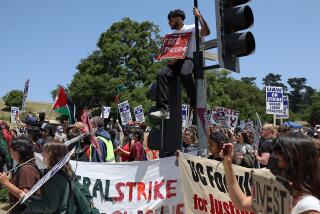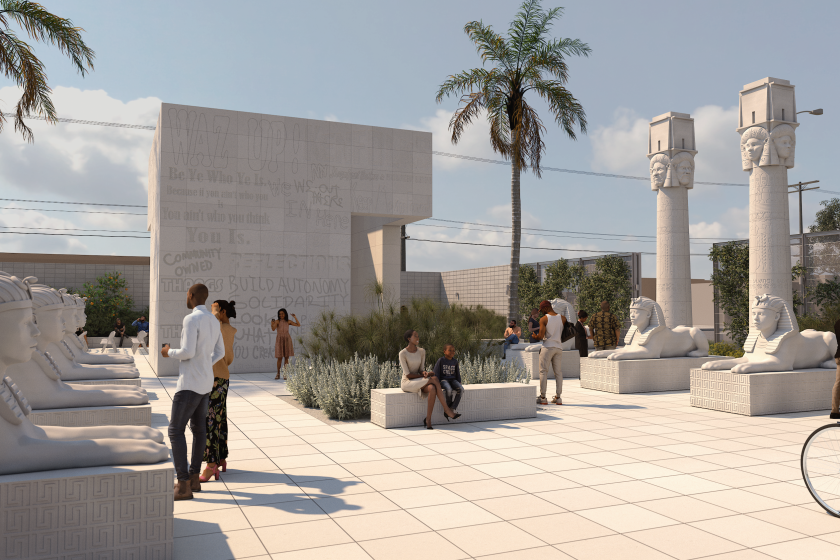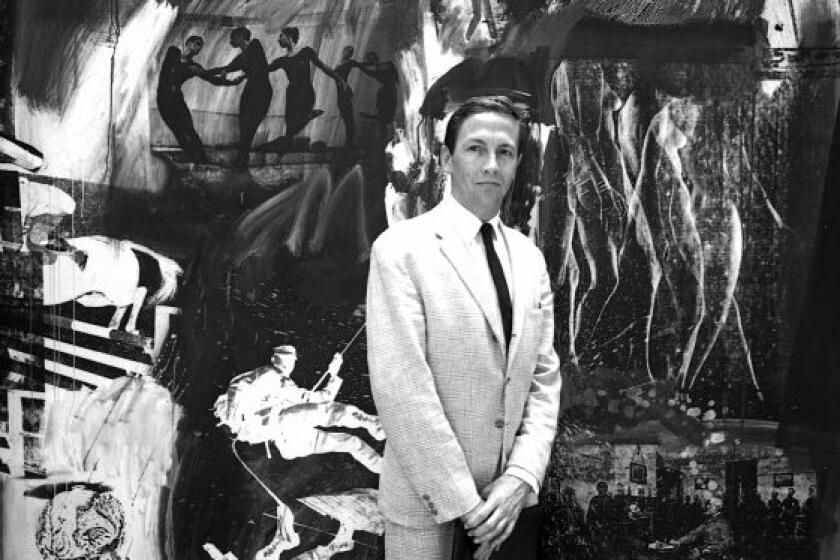When neighbors spoil the view
The priests who make their home in the residence attached to the new Cathedral of Our Lady of the Angels in downtown Los Angeles have a lot to be thankful for. Brand new digs and, more important, just outside their door are wonderful sculptures, lovely fountains and an inspirational place to worship.
However, part of the view leaves something to be desired. Some of the residence’s windows look directly out onto a steam-belching energy plant just across Hill Street. Pipes, cooling towers, industrial vents and some stained tile and metal walls stare back.
“It’s not L.A’s most beautiful building,” said one resident, Msgr. Terrance Fleming, who recently resigned his administrative position in the Roman Catholic archdiocese of Los Angeles. Then, with the tact of a neighbor: “I hope they would do something with it.”
He may just get his wish.
And Los Angeles may get lessons in how much the true nature of any structure can or should be camouflaged and how cities can combine urbanism with utilitarianism.
In more residential areas, when something big, new and shiny goes up, neighbors suddenly look at their own houses with more critical eyes. Paint jobs, re-sodding, new roofs and expansions then are launched.
Call it shame or civic duty, the county government is no exception to that basic fixer itch on a big scale. But instead of a mini-mansion as the goad, the driving forces are the recent completion of the cathedral and the continuing construction of the Walt Disney Concert Hall. Plus, a sense of trying to aid downtown’s renewal.
The potential fixer-uppers are that Central Heating and Refrigeration Plant near the cathedral and an Erector Set-looking multilevel parking structure on Bunker Hill directly in front of Disney Hall’s swooping stainless steel facade.
The county government, which owns both the plant and garage, hired the A.C. Martin Partners architectural firm in April to generate beautification ideas for those non-masterpieces of functional design. The recently completed designs from the $38,000 contract are not likely to be constructed quickly because of county budget problems. Still, they have stirred a lot of discussion.
“We are exploring things we might be able to do to enhance the appearance of these structures,” said Sharon Yonashiro, the county’s real estate asset manager. “I think it’s the right thing to think about.
“It’s part of our new awareness,” she added, “of the importance of the urban landscape.”
Construction costs are estimated at about $2 million for the energy plant and $1.5 million for the parking structure.
Along with the cost, the biggest challenge, everyone involved emphasizes, is that the power facility cannot be shut down and any new design elements cannot interfere with its operations. After all, the square-block power plant between Broadway, Hill, Temple Street and the 101 Freeway produces steam for heating and chilled water for air conditioning and sends those through tunnels and underground pipes to about a dozen buildings in the Civic Center, including courthouses and theaters. (The cathedral receives the cold water too.) As a byproduct, the facility also generates 30 megawatts of electricity.
All that cannot be made to look like a cutesy boutique, no matter how many flowering vines are planted along its walls or bright paint splashed onto cooling towers. Environmental and worker safety must be maintained and clearance for trucks and cranes kept open. So, the structure can’t be wrapped up, a la Christo, to resemble a giant hookah pipe with it puffs of white smoke emitting.
David Martin, design principal of his family’s multigenerational architecture firm, offered several concepts for the power plant. After review by county officials, the final version is sort of an artistic peek-a-boo.
In the model, translucent sculptural screens of perforated or woven metal are folded into crisp shapes and cover about two-thirds of the plant’s exterior. Along the top, a similar form creates a type of crown. Much more landscaping by the sidewalk could soften the industrial flavor. Everything might glow at night from lights behind the screens.
The original energy plant had some elegance to it, Martin said, but later additions over the past 50 years or so created a hodgepodge. “We are not trying to disguise the fact that it’s a power plant,” explained Martin. “Our idea was to restore the original and, in a very sculptural way, screen off the various additions to give it a sense of drama in the city.”
Yes, he concedes, there is “some whimsy” to his folded screen, some of which would be as large as 70 feet high. However, nothing in the plan would impede the work inside or the steam tunnels below.
That was important to Howard Choy, the county’s energy division manager. He said he understands “the desire to sort of make the whole downtown area have some sort of identity or uniqueness to it. My job is to make sure whatever they design doesn’t interfere with operation and functionality. I give them credit that they avoided that.”
Asked what he thought about the proposal aesthetically, Choy declined to comment. “I’m an engineer. What can I say?”
A few blocks away, the open-air parking structure with about 700 spaces is clearly hurting sightlines of Frank Gehry’s design for Disney Hall.
The parking structure, which officials recall was constructed as a temporary measure in the ‘70s, might be demolished in a few years as development of Bunker Hill continues. But in the meantime it is needed for jurors, courthouse visitors, county employees and others.
“It was a temporary, altogether Tinker Toy garage that wasn’t supposed to last more than a couple of years,” said architect Martin. “In an odd kind of way, I like the steel cross members and all that. But it doesn’t fit in with anything else there. It just doesn’t connect to the neighborhood.”
Martin’s proposal to beautify the garage is to cover parts of the exterior on most sides in sculptural screens of plastic that would mainly hide the parked cars. For the Grand Avenue side by the concert hall, something more dramatic is needed, he said. Perhaps crushed glass could be added into the screens facing Grand and First Street to create a refraction of headlights at night. Or perhaps a giant silk screen or photo or mural with a performance theme could be installed across that facade.
Yonashiro, the county official, said both plans are under study now and that county’s current budget crisis may make the next step difficult. “We want to try to do something within the constraints of our budget,” she explained.
Fleming, the Roman Catholic priest who lives across from the energy plant, will get a change of view long before the county makes a decision on the beautification construction. He is going on a sabbatical and then, with his resignation from his administrative post amid the diocese’s own money problems, he will be moving out of the cathedral residence early next year.
More to Read
Start your day right
Sign up for Essential California for news, features and recommendations from the L.A. Times and beyond in your inbox six days a week.
You may occasionally receive promotional content from the Los Angeles Times.







